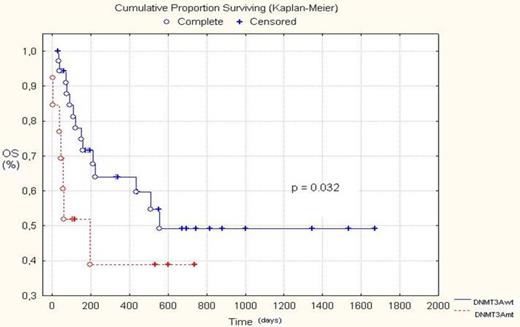Abstract
Objectives and background: Normal karyotype (NK) in AML patients accounts for nearly 45% of all cases and were assigned into intermediate risk group. The identification of new molecular markers in this group is the focus of most of researches. The application of the next-generation sequence techniques led to detect molecular markers with valuable prognostic significance. F.e., identification of DNMT3A mutations has gained the tremendous attention in recent times, because of its essential role in cell development, high frequency in AML patients and association of poor clinical outcome. Objects: to analyse character and frequency of DNMT3A mutations in AML patients; to study their associations with clinical and laboratory parameters and other molecular markers; to investigate their prognostic value.
Methods: The screening of DNMT3A mutations was performed by the high-resolution melting curve analysis. Mutations in FLT3, CKIT and NPM1 were analysed by polymerase chain reaction and in NRAS by sequencing. Standard GTG-method was used for patients karyotyping. The investigation group included 98 AML patients. Missense mutations of DNMT3A exon 23 (R882) were identified in 16 (16,3%) de novo AML patients. The most common mutation in DNMT3A was R882H (n=9;56.3%), followed by R882C (n=6;37.5%), and R882S (n=1;6.2%). All but one patients (with mutation R882S) were heterozygous and retained a wild-type allele. Patients with isolated DNMT3A mutations were seen in 3 cases; 3 pts with R882C had also mutations in NRAS; 3 pts had DNMT3Amut/FLT3-ITDmut; 1 pt - DNMT3Amut/FLT3-ITDmut/ FLT3-TKDmut; 4 pts - DNMT3Amut/FLT3-ITDmut/ NPM1mut and 3 pts - DNMT3Amut/ NPM1mut.
Results: Patients who harbored a mutation in DNMT3A had higher white blood cells count (p=0.039) at diagnosis and more frequently belonged to FAB group M4 (p=0.033), as compared with DNMT3A wild-type. Of the 16 patients who had AML with DNMT3A mutation, 13 (26.5%) had tumors with normal cytogenetic profiles (of a total of 49 cytogenetically normal samples) (p=0.006). There was no statistical correlation with other parameters, including sex, age, hemoglobin, and platelet count between patients with and without DNMT3A mutations (p>0.05). DNTM3A mutations were significantly more prevalent in NPM1 positive cases when compared to NPM1 wild type cases (p=0.000). DNTM3A mutations were also more dominant in FLT3-ITD positive pts than wild type (p=0.000). In contrast, DNMT3A mutations were not observed in cases with CKIT mutations indicating that these mutations can be mutually exclusive in nature. There was a statistical significance between overall survival (OS) of NK-AML pts with DNMT3A mutations and DNMT3Awt (p=0.032).
Conclusions: AML with DNMT3A mutations represent the group, homogeneous on a number of clinical and laboratory parameters. DNMT3A mutations are highly recurrent in patients with de novo AML with an intermediate-risk cytogenetic profile. FLT3-ITD and NPM1 mutations appear as a major significant coexisting genetic mutations in DNMT3Amut pts. The presence of DNMT3A mutations can be considered as independent adverse prognostic factor for OS, suggesting that testing of DNMT3A mutations can help further improve risk stratification in NK-AML.
References: Ley T.J., Ding L., Walter M.J., McLellan M.D. et al. DNMT3A mutations in acute myeloid leukemia. N Engl J Med 2010;363:2424-2433.
No relevant conflicts of interest to declare.
Author notes
Asterisk with author names denotes non-ASH members.


This feature is available to Subscribers Only
Sign In or Create an Account Close Modal